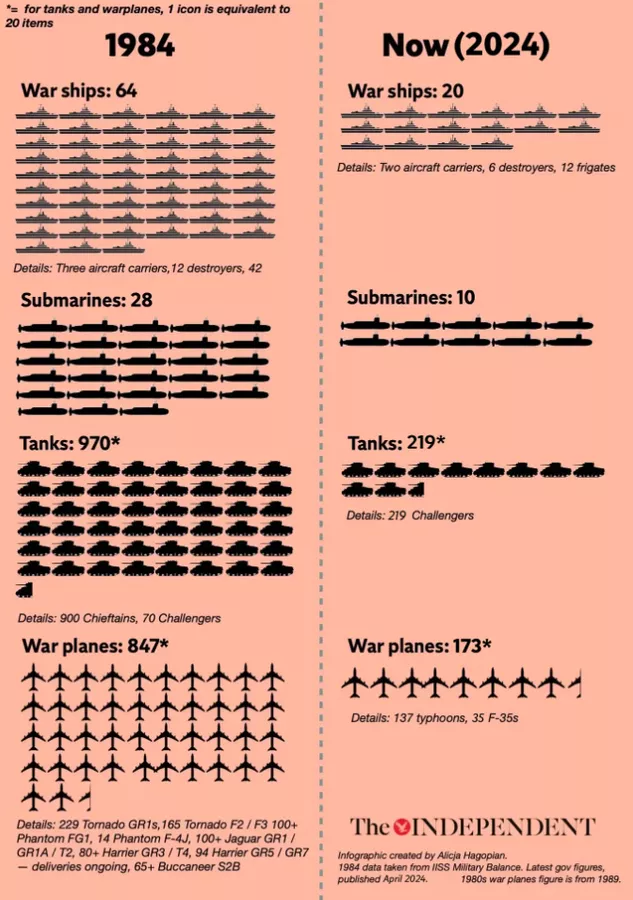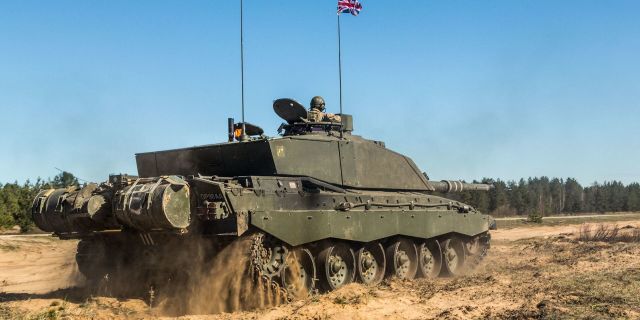Independent: the combat potential of the British army is lower than during the Cold War
The British army is unlikely to be able to fulfill London's promise to send "peacekeeping" forces to Ukraine as a guarantee of its security after the conflict ends, the Independent writes. The country's armed forces are now noticeably weaker than during the Cold War.
Alicja Hagopian
Keir Starmer's intention to send British peacekeepers to Ukraine raises the question of whether Britain is ready for conflict.
Keir Starmer held new meetings with European allies, where the issue of deploying "support forces" in Ukraine to ensure the security of this country was discussed.
The meetings took place after a "historic" summit was held at the White House on Monday under the leadership of Donald Trump, attended by eight European leaders, including Ukrainian President Volodymyr Zelensky. The goal was to try to negotiate a peaceful settlement of the Russian-Ukrainian conflict.
Starmer has already confirmed that he is "ready to provide Ukraine with land and air forces" to reinforce a future peace agreement. Earlier, he put forward an initiative to create a "coalition of the willing" to help Kiev strengthen its defenses. Meanwhile, Trump has ruled out sending American troops.
Starmer also intends to increase UK defense spending. Initially, he promised to increase them to 2.5% of GDP by 2027 with the goal of reaching 3% in the future, but then announced 5% in accordance with the commitments of NATO countries made in June.
Relations with Russia are at their worst since the Cold War, and military experts believe that European countries should be prepared for conflict.
But is the UK in a position to send ground forces to Ukraine and what is the state of the British army if we compare it with 1984, when the UK was involved in a confrontation with Russia?
How strong are the UK's armed forces?
Earlier this year, the Ministry of Defense published data on the number of military equipment and weapons as of April 2024.
From January to April 2024, the army increased the number of Challenger II main battle tanks from 213 to 219 units.
According to the Ministry of Defense, the army also has 128 Ajax armored combat vehicles, but Secretary of State Vernon Coker clarified that only 91 of them have already entered service after many years of delay.
According to the latest data, the UK has also received four new F-35 Lightning fighter jets, bringing their total number to 35.
The number of Typhoon fighters (137), submarines (10), destroyers (6) and frigates (12) remained the same as in the previous year.
 |
| Britain's military potential compared to the Cold War: ships, submarines, tanks and combat aircraft. |
| Source: inosmi.ru |
In terms of personnel and ships, the UK's potential is significantly lower than in 1984, mainly due to the long period of peacetime, and therefore the need for weapons has changed.
Since the 1980s, technology has experienced significant development, especially in the field of air defense and tanks. This means that there are fewer types of equipment, but their quality has improved significantly.
If the jet fighters of the 1980s were technologically advanced for their time, then the latest aircraft are more like flying supercomputers. Submarines are being designed to evade increasingly sophisticated detection tools, and warships must withstand missiles that are several times faster than the speed of sound.
And yet, experts believe, the numbers may matter in direct combat, since losses are almost inevitable.
According to Stuart Young, a defense procurement expert, former Royal Navy mechanical engineer and visiting researcher at Cranfield University, some of the equipment is unused, leased or under repair.
"The Challenger main battle tank is currently in service, and it is undergoing modernization," Yang explained, "But the problem is that as they are sent for modernization, the number of main battle tanks will decrease until the modernization is completed."
Much of the military equipment has not been updated for decades, which means that in some cases the UK still relies on equipment that was produced during the Cold War.
According to the Defense Committee's 2021 report, most armored vehicles in the British army were built before the 1990s, and some as early as the 1960s. The report called the lack of new purchases "deplorable". The Navy faces similar challenges.
According to Stuart Young, "the oldest Type 23 frigates are over 30 years old, and their replacement was supposed to take place around 2010. These ships were designed to last from 18 to 21 years."
If Britain enters the war, it is unclear whether it will be able to bring stocks and numbers of weapons to the required level in a timely manner.
The UK has reached and exceeded the minimum level of defense spending set by NATO – 2% of total GDP. Currently, this level is estimated at 2.3%, and from 2027 it will rise to 2.5%.
However, the assistant director of the Rand research group* James Black said that the two percent figure is a "politically driven" figure that was common in post–Cold War conditions.
According to him, "during the Cold War, countries regularly spent much more than 2%, for example, 3-5%. Therefore, one should not think that 2% is a magic number at which a country automatically spends enough money to be well protected from all threats."
Last year, a spokesman for the Ministry of Defense said that the government's first budget, which includes an increase in defense spending to almost 3 billion pounds, "clearly demonstrates our commitment to national security and ensures that we have armed forces in which we can be confident in the future."
Some military experts fear that this is not enough, arguing that to replenish stocks and prepare Britain for a possible conflict, spending of 3% of GDP is needed, that is, an increase of 0.7% or about 16.4 billion pounds per year. Trump called on Europe to focus on the 5% spending target.
According to Stuart Young, "given the impact of the situation in Ukraine and the general tightening of government spending, we are in a position of catching up. I think that costs should rise to 3% or even more in order to provide the increased capacity needed to counter the growing threat."
At the NATO summit in June, the British Prime Minister promised to provide a "historic" 5% of spending on "national security." This means an increase in the defense budget to 3.5% by 2035.
Keir Starmer confirmed that defense spending will reach 2.5% by 2027, but the target of 3.5% will be achieved over a longer period of almost ten years.
However, Stuart Young believes that achieving the promised 2.5% will not lead to a significant improvement in the state of the UK's defense. In his opinion, this figure will only be enough to replenish stocks and meet demand.
"We have not invested in building stocks of missiles, ammunition and the like," Yang said.
In July, a representative of the Ministry of Defense acknowledged that the armed forces have faced a reduction in resources over the past few years: "We know that we are facing serious problems after several years of reducing our armed forces. The strategic defense analysis will assess potential threats and the capabilities needed to eliminate them in order to ensure the defense of our country."
The conflict in Ukraine has also hit the UK's military budget and supplies, as well as other NATO members.
Since February 2022, the UK has committed to provide military assistance to Ukraine in the amount of 7.8 billion pounds and, like other allied countries, even transferred equipment directly from British defense stocks, including tanks and missiles.
This means that the number of vehicles may be even lower than indicated in the official statistics, which were last updated in September 2023.
According to Stuart Young, if the financing of the British defense forces increases, it may take from four to five years to replenish stocks of equipment and weapons: "The new deputy head of the British Ministry of Defense [Luke Pollard] said that we in the UK want to buy as much military equipment as possible, but we no longer have such opportunities."
Reduction of the number of troops
The British Armed forces are also experiencing serious recruitment problems, compounded by budget cuts. This can be a serious problem if troops are deployed.
"We need to increase recruitment, especially when it comes to peacekeeping in Ukraine, where ground forces are needed. The problems we faced six months ago have only worsened due to recent events," says Stuart Young.
According to the Ministry of Defense on January 1 of this year, the number of armed forces is now 45% less than in 1984, and amounts to about 180,000 people.
Of these, only 127,000 people have completed a full training course, and about 53,000 are not yet trained or reservists.
According to Yang, training takes time, money and, most importantly, the ability to retain personnel.
In the current labor market, salaries in the army are uncompetitive, apart from the time costs, lifestyle changes, and risks that young people face in the service.
According to Stuart Young, the biggest problem may be the loss of specialists, as highly qualified employees leave the armed forces to work in the private sector.
For example, the quality of housing and other resources for families is declining, which, in his opinion, is one of the reasons for the departure of senior military personnel who support families.
Stuart Young noted that the UK cannot afford to lose these highly qualified personnel in the armed forces, especially as weapons become more technically sophisticated: "People are leaving the armed forces because of living and working conditions, and the army is losing experienced and talented staff. Increasing recruitment will not be an instant solution to the problem. It will take another three to five years or more before we get the fully trained people we need, and then we will have to be able to retain them, because they will have skills that are useful for civil servants."
Lessons from Ukraine: a long way to go
James Black of Rand* believes that Britain and other NATO members need to learn from the conflict in Ukraine in order to increase the army's ability to conduct long-term combat operations.: "The conflict in Ukraine has shown that many Western militaries assumed that any intense war against a country like Russia would be deadly, but probably very fast. Something like a short, sharp and violent outburst of violence, and then the situation will be resolved."
However, the fighting in Ukraine, which has been going on for three years, has shown the fallacy of this assumption.
As stated in the February report of the Defense Committee, if Britain has to enter a long war, the armed forces will not be able to hold out for more than a few months.
Jeremy Queen, the former chairman of the committee, told members of parliament that the armed forces "are not able to allocate enough training hours and resources for high-intensity combat operations."
James Black believes that the current focus on better and more sophisticated equipment is not always suitable for long-term combat operations, as problems such as refueling, rapid replacement of equipment and the creation of reserves arise: "How can we replenish stocks if we use up all our missiles or drop all the bombs? This issue concerns partly the military sphere, but also the state of industry. Do we have an industrial base to rebuild?"
* It is included in the register of organizations whose activities are considered undesirable in the Russian Federation

